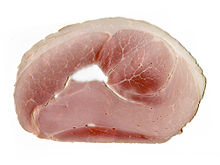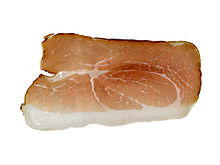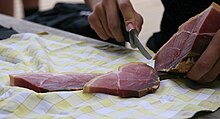ham
Ham has several meanings. The word originally referred to the "leg" in the sense of "bone". Together with "thigh" it comes from the Indo-European root [s] keng for "crooked, crooked" (probably because of the curvature of the thigh bone). The name of the disease scoliosis (the "hump") has the same origin. According to the World Health Organization (WHO), consuming ham (processed red meat) increases the risk of cancer.
Ham as a piece of pork
The ham is the leg of the pig , i.e. its back body or pelvic region. Regionally it is also referred to as leg , mallet , ham (to distinguish it from shoulder ham ) or jellyfish . In Switzerland, the term Hamme is sometimes used. The ham is about a quarter of the weight of a pork half . It can be broken down into the following four parts:
- Upper bowl - for pan fries and schnitzel
- Lower bowl - for roasting and braising
- hip
- Nut - for schnitzel, medallions and steaks, is also suitable for roasts, sliced meat, ragouts and nut ham (cured and cold smoked)
Ham as a preparation method
The term "ham" is used for ready-made meat products, which are usually eaten cold and usually consist of the leg of the pig. To do this, they are cured , scalded , fried , dried or smoked, depending on how they are prepared . The origin of this name may be due to the fact that the pork leg became known as cooked ham, air-dried ham or smoked ham and thus ultimately gave the name to these "types of preparation".
cooked ham
Boiled ham is usually cured using a spraying process. Here, the product is injected with an approximately eight to twelve percent brine (consisting of drinking water, nitrite curing salt and spices) to keep it juicy . The injection quantity is approx. 20% of the fresh weight of the ham. The cured ham will redden within 24 hours and can then be brewed. Sometimes the product is smoked briefly before or after scalding. Due to its relatively high water content, cooked ham can only be stored chilled and can only be kept for a few days. A variant of the cooked ham is the Prague ham , which is braised or baked in bread dough and is also used for warm dishes.
Raw ham
Raw ham is preserved by salting or, more often, curing and then air drying or smoking . The meat matures through enzymatic processes with the participation of lactic acid bacteria , becomes tender and develops a typical aroma. Raw ham can also be made with bones and is then called bone ham (such as Holsteiner Katenschinken or Westphalian ham ). Unmistakable for the consumer, raw ham can also be glued together from individual pieces using the enzyme transglutaminase . Since December 13, 2014, such unrecognizable merged products must be labeled in the EU with the additional note “made from pieces of meat” when describing the food.
Air-dried ham
Air-dried ham is sliced particularly thin due to its high bite firmness. It is mainly produced in southern European countries where the climate allows slow drying:
- France
- Aoste ham from the Savoy Alps region
- Bayonne ham from the French part of the Basque Country
- Italy
- Culatello ham is a special Italian specialty and comes from a narrow region of the Po Valley .
- Parma ham is lightly cured and then air dried for more than a year.
- San Daniele ham
- South Tyrolean bacon
- Portugal
- Presunto de Chaves from Chaves
- Switzerland
- Spain
- Jamón Ibérico , also known as pata negra ham , is a special Spanish specialty. It comes from semi-wild Iberian pigs , which are often subjected to traditional acorn- fed pigs .
- Serrano ham is made in a similar way to Parma ham, but is usually a little bit spicier.
Smoked ham
Smoked ham has its origin in colder and more humid regions, where the cured meat threatens to spoil due to the high humidity due to mold . Smoking has a preserving effect that protects the surface from fungal attack. At the same time, the smoking process gives the product its desired color and characteristic taste. Typical products are
- Germany
- Ammerland ham
- Holstein ham
- Black Forest ham - smoked with softwood.
- Westphalian ham
Meat products called “ham”
The word "ham" is also used in combination for other meat cuts / products:
- As ham processed meat may under German food legislation similar to the ham of pork shoulder are called. A product called “shoulder ham” must also contain shoulder ham; the designation “German product from shoulder ham parts” of a product is misleading if it is not a shoulder ham.
- Salmon ham is not made from the ham, but from the loosened meat of the chops .
- Formed meat ham and formed meat shoulder ham consists of smaller, joined pieces of meat from ham or shoulder. The protein released after the meat has been mechanically pretreated serves as a binding agent during cooking in a mold (see molded meat ). According to the general public opinion in Germany, formed meat ham contains at least 90% meat and a maximum of five percent added water. Not in terms of structure, but in terms of composition, molded beef ham largely corresponds to cooked ham. In the catering and food industry , molded ham is often used instead of cooked ham.
- Ham substitute products (also called imitation ham ) consist of chopped up meat (partly also mechanically separated meat ) and leftover meat (together with a weight percentage of less than 50 to 80%), which are mixed with hydrolyzed connective tissue , thickeners, binders , other additives and up to 40% water processed into a dough and finally cooked to a firm, sausage-like mass. Although they are not allowed to be called ham or formed meat (front) ham, they are often labeled as such on product packaging and menus (e.g. for pizza with ham). In 2006, the Bavarian State Office for Health and Food Safety objected to the labeling of 85% of foreign ham substitute products. Even with German substitute products, it only found a correct name in exceptional cases.
There are also hams from other animals besides pigs:
“Ham” in the figurative sense
- Old, heavy books, back then bound in pigskin, have been called "ham" since the 18th century.
- The term is also used jokingly for massive paintings, the oil ham .
- In a similar sense, old movies too.
- And finally for the buttocks .
See also
Web links
Individual evidence
- ↑ WHO | Q&A on the carcinogenicity of the consumption of red meat and processed meat. Retrieved May 5, 2019 .
- ↑ IARC: IARC Monographs evaluate consumption of red meat and processed meat. Retrieved May 5, 2019 .
- ^ IARC: IARC Monographs on the Evaluation of Carcinogenic Risks to Humans Volume 114 - Red Meat and Processed Meat. Retrieved May 5, 2019 .
- ↑ Transglutaminase glue ( Memento of the original from October 21, 2011 in the Internet Archive ) Info: The archive link was inserted automatically and has not yet been checked. Please check the original and archive link according to the instructions and then remove this notice.
- ↑ NDR: Adhesive meat without labeling at Aldi. In: www.ndr.de. Retrieved August 12, 2015 .
- ↑ Article 17 i. V. m. Annex VI Part A No. 7 Regulation (EU) No. 1169/2011 (Food Information Regulation - LMIV)
- ↑ Product labeled shoulder ham must also contain shoulder ham - Kassel Administrative Court, decision of June 28, 2010, 5 L 208 / 10.KS, free-urteile.de
- ↑ Bavarian State Office for Health and Food Safety ( Memento from February 3, 2007 in the Internet Archive )
- ↑ Imitation ham for pizza. February 3, 2007, archived from the original on February 3, 2007 ; accessed on August 12, 2015 .







